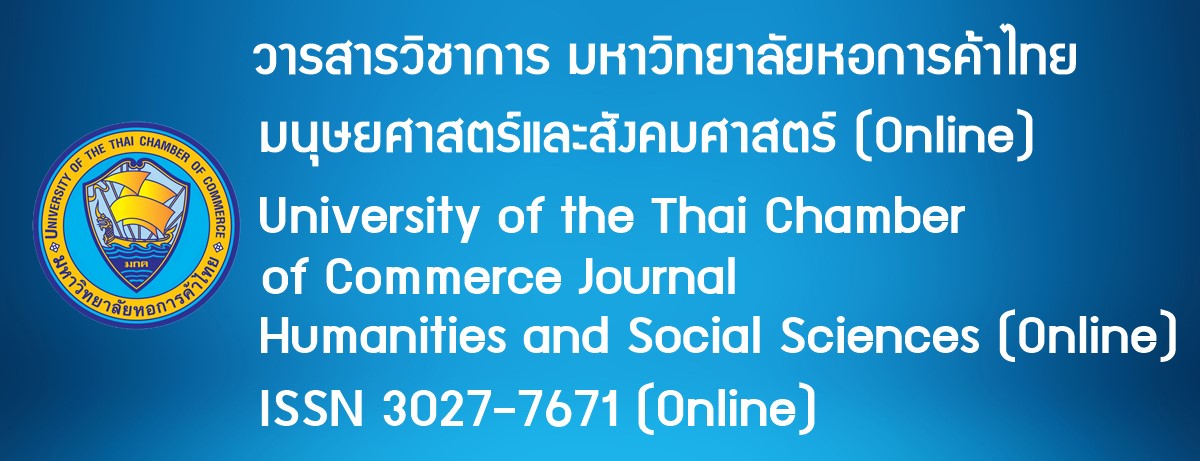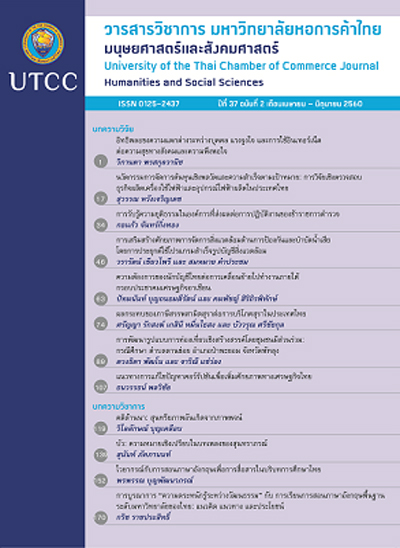กลยุทธ์เศรษฐกิจสร้างสรรค์ที่มีผลต่อความสำเร็จขององค์กรธุรกิจ: กรณีศึกษา ผู้ประกอบการอุตสาหกรรมในจังหวัดนครปฐม
Main Article Content
บทคัดย่อ
วัตถุประสงค์ของงานวิจัยนี้คือ เพื่อศึกษากลยุทธ์เศรษฐกิจสร้างสรรค์ที่ใช้ในองค์กรธุรกิจ ประกอบด้วย ด้านการสร้างความแตกต่างของผลิตภัณฑ์ ด้านการเป็นพันธมิตร ด้านการผลิตที่เป็นมิตรกับสิ่งแวดล้อม ด้านนวัตกรรม ด้านพนักงานและด้านการตลาดที่มีผลต่อความสำเร็จขององค์กรธุรกิจอุตสาหกรรมในจังหวัดนครปฐม ประกอบด้วย ด้านรายได้ ด้านผลกำไร ด้านความมั่นคง ด้านความพึงพอใจของลูกค้าต่อสินค้าและด้านจำนวนลูกค้าในปีปัจจุบัน โดยเน้นศึกษาผู้ประกอบการหรือผู้บริหารในระดับตำแหน่งงานตั้งแต่ผู้จัดการขึ้นไปที่ประกอบธุรกิจอุตสาหกรรมในจังหวัดนครปฐม รวม 400 ตัวอย่าง โดยใช้แบบสอบถามเป็นเครื่องมือในการเก็บรวบรวมข้อมูลจากกลุ่มตัวอย่าง สถิติที่ใช้ในการวิจัยได้แก่ ค่าร้อยละ ค่าเฉลี่ยเลขคณิต ค่าส่วนเบี่ยงเบนมาตรฐาน และใช้การวิเคราะห์การถดถอยเชิงเส้นแบบพหุคูณในการทดสอบสมมติฐาน โดยผลการวิจัยพบว่า กลยุทธ์เศรษฐกิจสร้างสรรค์ในแต่ละด้านมีผลต่อความสำเร็จขององค์กรธุรกิจ โดยด้านการตลาด มีผลทางบวกต่อความสำเร็จขององค์กรธุรกิจในเชิงเส้นตรงมากที่สุด (bCS6 = 0.521) รองลงมาคือ ด้านการสร้างความแตกต่างของผลิตภัณฑ์ (bCS1 = 0.437) และด้านนวัตกรรม (bCS4 = 0.389) ที่ระดับนัยสำคัญทางสถิติ 0.01 สามารถอธิบายความผันแปรได้ร้อยละ 67.50
Article Details
ลิขสิทธิ์ของบทความ
ผลงานที่ได้รับการตีพิมพ์ถือเป็นลิขสิทธิ์ของมหาวิทยาลัยหอการค้าไทย ห้ามมิให้นำเนื้อหา ทัศนะ หรือข้อคิดเห็นใด ๆ ของผลงานไปทำซ้ำ ดัดแปลง หรือเผยแพร่ ไม่ว่าทั้งหมดหรือบางส่วนโดยไม่ได้รับอนุญาตเป็นลายลักษณ์อักษรจากมหาวิทยาลัยหอการค้าไทยก่อน
References
Budsankom, P. (2011). Selection process for multiple regression. Journal of Educational Measurement Mahasarakham University, 17(1), 43-60. (in Thai).
Chamchan, C., & Boonyamanond, S. (2013). Roles of creative economy for community and social development in Thailand. NIDA Economic Review Journal, 7(1), 109-151. (in Thai).
Donkwa, K. (2016). A model of factors in creative economics and innovative behavior affecting the long-run AEC strategies of Thailand. Nakhon Ratchasima, Thailand: Suranaree University of Technology. (in Thai).
Erwan, P. (2017). Indicators of business success for entrepreneurs. Retrieved March 20, 2017, from https://www.bangkokbiznews.com/recommended/detail/424 (in Thai).
Finklestien, R. (2006). What successful businesses have in common. Retrieved August 15, 2016, from https://www.entrepreneur.com/article/83764
Foley, P., & Green, H. (1989). What is success: Small business success. Lodon, England: Chapman.
International Institute for Trade and Development. (2011). Creative economy and development issues in Thailand. Bangkok, Thailand: Chulalongkorn University. (in Thai).
Jonpradit, S. (2013). The influence of applying creative economy concept, factors driving creative economy and characteristics of entrepreneurs to market success factors of five-stars One Tambon One Product (OTOP) in Thailand (Unpublished doctoral dissertation). Dhurakij Pundit University, Bangkok, Thailand. (in Thai).
Kaewphanngam, C., & Tharmmapornphilas, R. (2013). Education policy and human resource development in Thailand under creative economy. NIDA Economic Review Journal, 7(1), 251-306. (in Thai).
Kanthachai, N. (2015). Quality management and market orientation affecting the organizational performance of SMEs in Thailand. University of the Chamber of Commerce Journal, 35(4), 42-53. (in Thai).
Lekmat, L., & Hongratanawong, L. (2017). Value creation in pineapple industry. University of the Thai Chamber of Commerce Journal, 37(1). 79-90. (in Thai).
Office of Industrial in Nakhon Pathom Province. (2015). Investment report in Nakhon Pathom Province 2015. Nakhon Pathom, Thailand: Author. (in Thai).
Porter, M. E. (1990). Competitive strategy: Techniques for analyzing industries and competitors. New York: Free Press.
Sirikudta, S. (2013). Creative economy strategies affecting business organization success: Case study of upper central part industrial entrepreneurs. Kasetsart Journal (Social), 34(3), 428-439. (in Thai).

